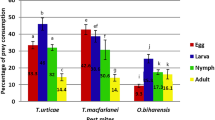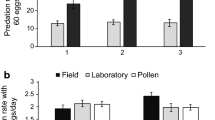Abstract
Observations were made on the feeding behavior of the two main phytoseiid species in Spanish Citrus orchards,Euseius stipulatus (Athias-Henriot) andTyphlodromus phialatus Athias-henriot. The experiences were carried out by rearing the predatory mites on excised orange leaves, and always with an excess of the prey the Citrus Red Mite (=CRM)Panonychus citri (McGregor). In experiments with all stages of CRM, the number of prey killed per hour was 5.12 and 2.00, the percentage of successful attacks, 58% and 21%, and the mean time spent feeding on each prey was 5.1 and 12.2 minutes for starving females ofE. stipulatus andT. phialatus respectively.E. stipulatus feeds on all stages of the prey except eggs, andT. philatus, on all stages, except males. Both species attack much less successfully females ofP. citri rather than immatures. In experiments with adult females and eggs ofP. citri as prey, the mean number of prey killed daily was 4.51 females forE. stipulatus, and 2.01 females and 2.12 eggs forT. philatus. Considering this killing rate and the number of eggs laid by the predators in the same period, it can be concluded thatE. stipulatus consumes only 30% of the content of the preys killed, whereasT. philatus consumes a percentage of prey variable between individuals and ranging from 40% to 100%. These differences in feeding behavior between the two species could partly explain differences in their efficiency as biocontrol agents ofP. citri observed in the field.
Résumé
On a étudié le comportement alimentaire des deux principales espèces de phytoséiides présents dans les vergers de Citrus en Espagne,Euseius stipulatus (Athias-Henriot) etTyphlodromus phialatus Athias-Henriot. Les expériences ont été menées en élevant l'acarien prédateur sur feuilles d'oranger, avec un excès de sa proiePanonychus citri (McGregor). Dans les essais avec tous les stades de l'acarien rouge, le nombre moyen de proies tuées par heure est de 5.12 et 2.00, le pourcentage d'attaques réussies de 58% et 21% et le temps moyen passé à se nourrir sur chaque proie de 5.1 min et 12.2 min respectivement pour les femelles d'E. stipulatus etT. phialatus.
Tous les stades de développement, excepté le stade œuf, peuvent être consommés parE. stipulatus tandis queT. phialatus se nourrit de tous les stades, à l'exception des mes. Chez les deux espèces, les femelles deP. citri sont attaquées avec moins de succès que les immatures.
Lorsque les proies sont constituées de femelles adultes ou d'œufs deP. citri le nombre moyen de proies tuées quotidiennement est de 4.51 femelles pourE. stipulatus, et de 2.01 femelles et 2.12 œufs pourT. phialatus.
Si l'on considère le nombre d'œufs pondus par les acariens prédateurs durant la même période,E. stipulatus ingère seulement 30% du total des proies tuées, alors queT. phialatus ingère un nombre de proies variable selon les individus, allant de 40 à 100%. Ces différences d'alimentation chez ces deux espèces pourraient expliquer en partie leurs différences d'efficacité observées sur le terrain, en tant qu'agents de lutte biologique.
Similar content being viewed by others
References
Badii, M. H. andMcMurtry, J. A. — 1984. Feeding behavior of some phytoseiid predators on the broad mitePolyphagotarsonemus latus (Acari: Phytoseiidae: Tarsonemidae). —Entomophaga, 29, 49–53.
Blommers, L., Lobbes, P., Vink, P. andWegdam, F. — 1977. Studies on the response ofAmblyseius bibens (Acarina: Phytoseiidae) to conditions to prey scarcity. —Entomophaga, 22: 247–258.
De Moraes, G. J. andMcMurtry, J. A. — 1981. Biology ofAmblyseius citrifolius (Denmark and Muma) (Acarina: Phytoseiidae). —Hilgardia, 49: 1–29.
Ferragut, F., García-Marí, F., Costa-Comelles, J. andLaborda, R. — 1987. Influence of food and temperature on development and oviposition ofEuseius stipulatus (Athias-Henriot) andTyphlodromus phialatus Athias-Henriot (Acari: Phytoseiidae). —Exp. Appl. Acarol., 3: 317–329.
Friese, D. D. andGilstrap, F. E. — 1982. Influence of prey availability on reproduction and prey consumption ofPhytoseiulus persimilis, Amblyseius californicus andMetaseiulus occidentalis (Acarina: Phytoseiidae). —Internat. J. Acarol., vol. 8, n0 2: 85–89.
García-Marí, F., Ferragut, F., Marzal, C., Costa-Comelles, J. andLaborda, R. — 1986. Acaros que viven en las hojas de los citricos españoles. —Inv. Agr. Prod. Prot. Vegetal, vol. 1 (2): 61–92.
Hoyt, S. C. — 1970. Effect of short feeding periods byMetaseiulus occidentalis on fecundity and mortality ofTetranychus mcdanieli. —Ann. Entomol. Soc. Am., 63: 1382–1384.
Sabelis, M. W. — 1985. Predation on spider mites. In Spider Mites. Their Biology, Natural Enemies and Control. (Helle andSabelis ed.). — Elsevier, Amsterdam Vol. 1B, pp. 103–129.
Sandness, J. N. andMcMurtry, J. A. — 1970. Functional response of three species of Phytoseiidae (Acarina) to prey density.Can. Ent., 102: 692–704.
Sandness, J. N. andMcMurtry, J. A. — 1972. Prey consumption behavior ofAmblyseius largoensis in relation to hunger. —Can. Ent., 104: 461–470.
Tanigoshi, L. K. — 1981. Advances in knowledge of the biology of the Phytoseiidae.In: Recent advances in knowledge of the Phytoseiidae (M. A. Hoy ed.). Univ. California. pp. 1–22.
Van de Vrie, M. — 1974. Studies on prey-predator interactions betweenPanonychus ulmi andTyphlodromus (A.)potentillae (Acarina: Tetranychidae, Phytoseiidae) on apple in the Netherlands. — Proceedings FAO Conference on Ecology in relation to pest control. Rome, pp. 145–160.
Author information
Authors and Affiliations
Rights and permissions
About this article
Cite this article
Ferragut, F., Laborda, R., Costa-Comelles, J. et al. Feeding behavior ofEuseius stipulatus andTyphlodromus phialatus on the citrus red mitePanonychus citri [Acari: Phytoseiidae, Tetranychidae]. Entomophaga 37, 537–544 (1992). https://doi.org/10.1007/BF02372323
Received:
Accepted:
Issue Date:
DOI: https://doi.org/10.1007/BF02372323




